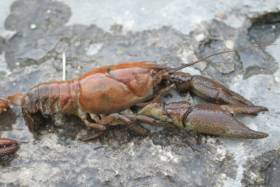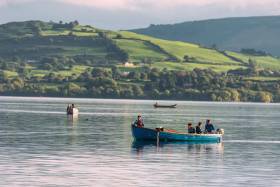Displaying items by tag: Athlone
Continued Restrictions Around New Shannon Bridge Works in Athlone as First Section Set to Be Floated Into Place
Waterways Ireland advises all masters of vessels and waterways users on the Shannon Navigation that restrictions around the construction of the new pedestrian and cycleway bridge in Athlone will continue until the end of next month.
Additionally, the first section of the bridge will be floated downstream from Wansboro Field on a large pontoon from Tuesday 30 to Wednesday 31 August.
Two tugs will be manoeuvring the 18 sqm pontoon, and two safety boats will be on the river during the bridge moving operation.
In preparation for the bridge moving operation, the three upstream sections of the new Waterways Ireland jetty at the railway bridge will be removed from Thursday 25 August.
All power and water to the remaining sections of the jetty will be disconnected for safety reasons from this date, and the red navigation markers at the railway bridge will also be removed.
No vessel will be allowed to moor on this jetty from 8pm on Monday 29 August until 8pm on Wednesday 31 August.
Masters of vessels are advised to proceed with additional caution in the vicinity of the works and to follow the instructions of safety craft and personnel in the area, the cross-border body for Ireland’s inland waterways says.
Waterways Ireland advises masters of vessels on the Shannon Navigation that Athlone Lock will be temporarily closed on Thursday 11 and Friday 12 November to facilitate further flood relief works.
Waterways Ireland wishes to advise masters of vessels on the Shannon Navigation that Athlone Lock will be temporarily closed from next Monday 1 November until Wednesday 3 November inclusive to facilitate flood relief works.
Athlone Women Raise More Than €11k for Lough Ree RNLI in Marathon Swim
Athlone open water swimmers Serena Friel and Karen Reynolds have presented Lough Ree RNLI with a cheque for €11,300 following a fundraising swim on the lake last month.
Throughout this year the women, who have been swimming regularly at Coosan Point, admired the progress on the new boathouse for the lifeboat which is under construction on the lake shore.
When they heard of an initiative to raise a local community contribution of €100,000 for the facility, they decided to lend their support.
Under the careful eye of their coach David Warby from Athlone Regional Sports Centre. they set about the task of training to swim the length of Lough Ree — a challenging 32km from Lanesboro Bridge on the Longford/Roscommon border to the Town Bridge in Athlone.
They completed the task last month in a record time of 10 hours 13 minutes.
On Thursday last (16 September) Serena and Karen visited the Lough Ree RNLI facility at Coosan Point and presented treasurer Vincent Rafter with a cheque for €11,300 — more than 10% of the overall target.
 Karen Reynolds and Serena Friel with a lake chart of their swim route | Credit: RNLI/Tom McGuire
Karen Reynolds and Serena Friel with a lake chart of their swim route | Credit: RNLI/Tom McGuire
At the presentation, Serena thanked everyone who had supported them in the ‘Lough Ree Challenge’, especially Midland Print, Cantwell Corporate Finance, the staff of Athlone Mail Centre and clients of Serena’s Hair Studio.
Karen thanked “everyone who had contributed to the fund and especially logistics coordinator Carmel Hughes and Catriona Cantwell for social media”.
Accepting the generous donation, Vincent Rafter said: “Both women have made an invaluable contribution to the charity and to water safety on the lake and River Shannon.”
So far this year Lough Ree RNLI has responded to 42 callouts to people and vessels in difficulty on the water.
This week Lough Ree RNLI also received a generous contribution to the fund of €1,500 from RBK Chartered Accountants.
The station has a local bank account where all donations, large or small, are welcome. The account name is Loughree RNLI Boathouse Appeal, the BIC is AIBKIE2D and the IBAN is IE80AIBK93226458090098.
Waterways Ireland advises masters and owners of vessels that instream work will commence on the new slipway south of the Athlone Lock from tomorrow, Wednesday 4 August.
Works will also take place on the East Bank some 200m south of the weir on the Shannon Navigation. Temporary green navigation aids will be placed on the western extremities of the works area.
Masters of vessels are advised to proceed with additional caution at slow speed and keep to the West Bank while navigating in this area of the inland waterway.
High Water Levels on Shannon Hit Rowing Clubs Hard
Rowing clubs along the Shannon have been badly affected by high water levels. Carrick on Shannon and Athlone have both been hit, while Castleconnell is flooded. This came despite pumping. The gym equipment had been moved out and the boats are stored higher up the bank.
This ESB at Ardnacrusha stated: “Due to heavy rainfall in the catchment we will be increasing discharge from Parteen Weir. You are being notified that water is about to be discharged above 325 m3/sec. This will result in flooding of roads, land and may affect property. You are advised to be aware of increased flows in the river as a result of this water discharge. Further increases in discharge may be required. Approx. 400 m3/sec will be discharged.”
Water Users Called On To Help Limit Crayfish Plague Outbreak In Athlone
All water users along the River Shannon are being urged to take precautions after confirmation of an outbreak of crayfishrayfish plague on a stretch of the Al River.
This river is one of the main tributaries to the River Shannon in Athlone and flows westerly, entering the Shannon downstream of the weir.
A small number of dead freshwater crayfish were reported on the river last week. DNA analysis by the Marine Institute has now confirmed that crayfish were infected with the fungus-like organism responsible for causing crayfish plague.
Further analysis is still ongoing to establish if there may be any links between this and previous outbreaks of crayfish plague.
Crayfish plague only impacts native white-clawed crayfish. Fish and other freshwater animals are not affected.
The disease infects species of crayfish and experience elsewhere indicates the disease can cause up to 100% mortality in white-clawed crayfish species.
Agencies including the National Parks and Wildlife Service, Westmeath Municipal and County Councils will be working together to erect signage along the Al River and information will be on the Westmeath County Council website.
Crayfish plague is recognised as a very significant threat to the survival of the globally threatened white-clawed crayfish in Ireland.
The disease is considered fatal to all infected native crayfish and the experience in other countries is that where outbreaks occur there is complete extermination of white-clawed crayfish populations. It is spread invisibly in water and the infectious stage may be moved to other river and lake systems on equipment, boats and machinery.
The crayfish plague comes from the North American species of crayfish, which are now widespread in the UK and on the continent of Europe. To date there are no known records of these American species in Ireland and it is against the law to bring them into Ireland, to sell them, distribute them or release them.
This is the seventh confirmed outbreak of the disease in the whole of Ireland since it was first found in 2015 in Co Cavan, followed by four separate confirmed outbreaks in 2017 and one confirmed outbreak in Northern Ireland earlier this year.
The closest known previous outbreak to this was one in the Lorrha in Co Tipperary and it is not known how the disease could have spread to the River Al at this time.
Anyone involved in activities in the Al River and River Shannon should observe the ‘Check, Clean and Dry’ protocol once they leave the river and before visiting any waterway again. This includes community and local authority clean-up groups, survey work, as well as anglers and all recreational water uses.
All wet gear (boats, clothing and equipment) should be checked for any silt or mud, plant material or animals before being thoroughly cleaned and finally dried.
Disinfectant or hot water (over 40 degrees Celsius) should be used to clean all equipment and this should be followed by a minimum 48-hour drying period (preferably longer, up to a week).
Members of the public will see any dead or dying crayfish should report this to National Parks and Wildlife Service, Westmeath County Council, or Colette O’Flynn at the National Biodiversity Data Centre, Waterford at [email protected].
Anyone who suspects they have seen a non-native species of crayfish are asked to take a picture of it showing the underside of the claws and submit via the National Biodiversity Data Centre’s invasive species record form or direct to Colette O’Flynn.
Have A Taste At The Athlone Shannon Feastival This Weekend
The Athlone Shannon Feastival this weekend 8-9 September expects to attract thousands of people to the Midlands town to take part in and enjoy the action packed lineup of activities on and off the Shannon and Lough Ree waterways.
This year's Feastival is the opening act to the World Canals Conference from 10 September, expected to attract over 400 delegates from all over the world to Athlone.
The Radisson Blu Festival Marquee, located at the walls of Athlone Castle, will be the hub for the festival, hosting workshops, talks, demos and kids’ entertainment.
The Feastival’s official launch event takes place on Saturday afternoon at 4pm when the Sheraton chefs will be busy shucking oysters to accompany Guinness from Sean’s Bar and jazz at the Feastival HQ.
Vikings are landing and will set up the Sheraton Viking Settlement at The Strand, where visitors can experience Viking life by exploring the medieval village and seeing weapon making, embroidery, medieval cooking and more.
On Saturday evening, local chefs sharpen their knives and wield their tongs for the Viking BBQ Cook-Off at 6pm, an event sure to satisfy the appetite.
On Sunday, why not treat yourself by visiting the Sirana Spa Wellness Area for some pampering? Or for a bit more action, watch the local crews as they battle it out to be crowned ‘Champions of The Shannon’ in the leisure boat rowing races.
Professional flyboarders take centre stage at 4pm as they hover over the river performing a variety of amazing stunts and tricks.
The Flogas Demo Kitchen hosts a series of foodie talks, cooking demos and tasty treats all afternoon. And at 6pm Viking Mike casts off and sets sail for a Viking whiskey cruise hosted by Midlands Whiskey Experiences.
Cafés and restaurants participating in the Feastival Food Trail all weekend include The Fatted Calf, Kin Khao, Thyme, Smoke BBQ, The Corner House Bistro, Fine Wine & Food Company, La Cucina Di Angelo, Radisson Blu Hotel, Hodson Bay Hotel, Sheraton Athlone Hotel and The Prince Bar, with more to be announced.
Fashion puts its best foot forwards at The Feastival Fashion Trail. Burgess department store hosts a series of workshops from 11:30am on Saturday with Kathryn Byrne of Your Image Matters, and Athlone Town Centre hosts a ‘Style Squad’ event with stylist Rebecca Rose and Tanya from the My Little Love Stories blog from noon to 4pm.
Meander the Music Trail around Athlone’s pubs featuring sessions at Sean’s Bar, The Snug, The Castle Inn, Fiddler’s Bar, The Malt House, Sheraton Athlone Hotel Bar, the Quayside Bar at the Radisson Blu Hotel, The Prince Bar, and the Waterfront Bar in the Hodson Bay Hotel.
The Artisan Food Village, open Saturday and Sunday, will showcase the best of locally produced food from producers including Kilbeggan Chocolate, Tara Jams, Wild Irish Foragers, KO Kombucha, Quarrymount Farm, Durrow Mills, Behan’s Fruit & Veg, Harvest Café, Radisson Blu Hotel, Prince of Wales Hotel and more.
Other highlights of the weekend include:
- Heritage boat spectacle and cruiser flotilla.
- Whiskey walking tours and tastings with Athlone Whiskey Tours.
- Performances by The Band of the 2nd Brigade and recitals of ‘Poetry in the Park’ at Athlone Castle.
- Free guided tours at selected times at Athlone Castle and Luan Gallery.
- ‘Reflections’, a special Waterways Ireland archive exhibition at Abbey Road Artist Studio and Luan Gallery.
“There’s a palpable air of enthusiasm around in advance of the Feastival,” said Athlone Chamber’s John McGrath. “And it’s great to see local businesses jumping on board and supporting the event in so many ways."
World Canals Conference Looks To China For Inspiration
#WCC - Zhu Minyang completes the list of keynote speakers at the upcoming World Canals Conference in Athlone next month.
Zhu has been the chair of the World Historical and Cultural Canal Cities Cooperation Organization (WCCO) since 2012, and has also served as party secretary of the city of Jiangyin and as mayor of Yangzhou, the ‘first city of the Grand Canal’.
Zhu personally participated in the selection of China’s Beijing–Hangzhou Grand Canal for the World Heritage List in 2014. He has extensive insights and experience in the development of Chinese social organisations and contemporary social governance.
Through his leadership, the WCCO has become a platform for economic and cultural exchanges focused on the world’s canal cities.
Zhu will address the conference on how the WCCO is supporting the renovation of China’s most famous canal. Through economic and ecological restoration and investment in heritage and cultural research, it is intended that a “human community with shared destiny” will develop to create deeper co-operation and regeneration opportunities for China’s canals.
Zhu Minyang will address the conference under its first theme, ‘Restore’, which calls for reflection on how 200-year-old man-made navigations remain relevant for people today.
Over the course of the conference, a variety of speakers from across Europe, Canada and the US will detail restoration works along their waterways as well as how they ensure that no heritage value is lost in these restorations.
John McKeown will speak on restoring the Royal Canal, Roger Squires will cover new approaches to restoration, while Pam Veinotte discusses evolving heritage assets to meet modern-day needs.
Restoration of the Shannon–Erne Waterway is the subject of Joseph Gillespie’s talk, while
Rudy Van der Ween talks the re-opening of the Lower Scheldt in the city centre of Ghent in Belgium, and Rob Vrojliks puts the focus on Limburg in the Netherlands and its regional masterplan approach.
From the US, William Holdsworth will explain how the Chesapeake & Ohio Canal Aqueduct restoration at Williamsport, Maryland brings history alive, while Theron Robson talks maintenance of heritage lock gates on the River Shannon, and Roger Alsater assays preservation efforts for the Göta Canal in Sweden.
‘Regenerate’ (focused on water management challenges) and ‘Reimagine’ (on engaging a wider audience with their local waterways) are the other two tracks at the World Canals Conference which begins in 37 days’ time. Details can be found on the World Canals Conference website.
President Michael D Higgins To Speak At World Canals Conference In Athlone This September
#InlandWaters - President of Ireland Michael D Higgins has been confirmed as a guest of honour at the World Canals Conference in Athlone this autumn.
“We are honoured that the President who throughout his career has demonstrated his commitment to and love of the inland waterways of Ireland, their history and culture, has agreed to speak at the conference and we look forward to hearing how he perceives the restoration, regeneration and reimagining of the waterways,” organisers said.
There are 53 days and counting till the three-day conference from 10-12 September at the Radisson Blu Hotel Athlone under the theme ‘restoring, regenerating, re-imagining’ — with various tours and sessions designed to inspire and connect delegates coming to the Midlands from all around the world.
These tours include an excursion around Lough Derg, the largest and most southerly lake on the River Shannon, that takes in the 1700s bridge linking Killable and Ballina as well as the Ardnacrusha hydroelectric plant, and will explore the challenges of doubling moorings along an old navigation.
Another technical tour will explore the North Shannon, Lough Allen Canal and the Shannon-Erne Waterway, with a stop at the Acres Lake floating boardwalk and a look at the marriage of modern and traditional locks at Kilclare.
As previously reported on Afloat.ie, the conference will be preceded by the three-day Shannon Athlone Feastival, highlighting local food producers in an exciting festival atmosphere with rowing, raft racing, a Viking village and demonstrations of flyboarding that wowed the crowds at the recent SeaFest in Galway.
Special rates for accommodation on board luxury cruise liners are still available, as are a range of exhibition opportunities for organisations looking to network with delegates. Details can be found on the World Canals Conference website.


































































